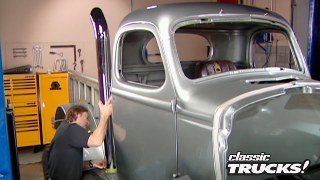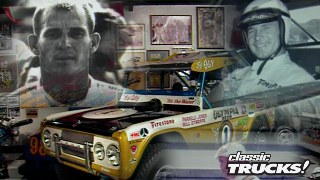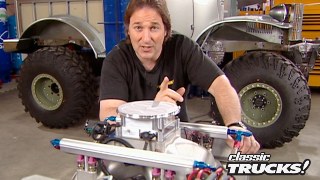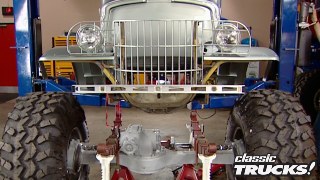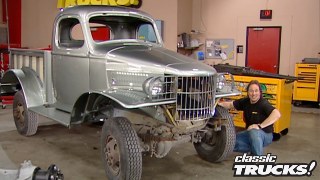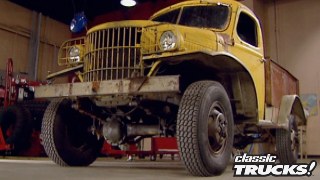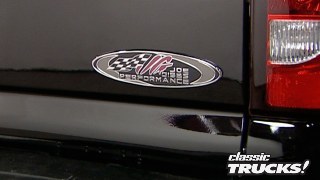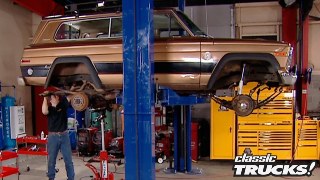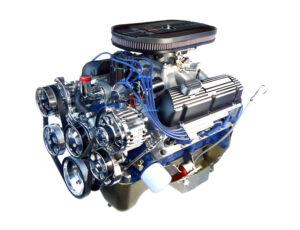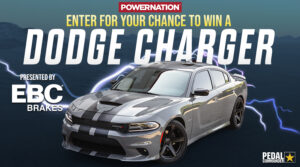Classic Trucks! Builds
Want more content like this?
Join the PowerNation Email NewsletterVideo Transcript
You know, since the beginning of the whole automotive era, gearheads have been obsessed with two things. Number one, buying a vehicle, number two, making it faster so you could go out and beat your buddies.
Heck, the whole automotive industry has been based on competition.
That's why we had the muscle car wars and that's why we've got drag racing and that's what NASCAR
is. But trucks,
uh, trucks for the longest time haven't really shared that history.
Now, they were a tough, rugged utilitarian vehicle great for off road racing, but
not necessarily something that you would take to the track. And then Ford came out with the lightning and boom.
There's a demand for fast trucks and that's what we're looking at today.
Muscle trucks. And if you haven't experienced the lightning
here it is
who the lightning is the brainchild of Ford SVT
and has continued to evolve over the years.
But its main purpose is to go fast.
What does that mean?
Who fell
for the truck part? It has the ability to comfortably carry an 800 pound payload in the bed
and the hitch is not fake.
This thing will pull a 5000 pound trailer without even breathing hard
for the muscle part. You've got a 5.4 triton V8 with an eaten supercharger ramming eight pounds of boost down his throat
while a water to air inner cooler removes excess heat
and adds even more power. This adds up to 380 horsepower and 450 ft pounds of torque.
A special four speed automatic tranny channels that power to 373 gears in a limited slip rear end
ensuring that you leave two cool black marks instead of just one dorky. One
of course, all that power is no good if you can't handle it.
But the lightning can, it's got quick ratio steering box along with SVT, special springs, gas shocks and stabilizer bars in front and the rear.
This not only lowers the truck,
it makes it extremely agile in turns with very little body
rounding out. The package are special Goodyear tires for gripping the road. So you can flog this thing like a sports car,
but you still have some side wall string if you need to do some towing,
obviously, braking is important and the lightning shines there too with four wheel discs
with a Ds to stop this thing in a hurry.
However, the awesome drive train and suspension aren't just for the drag strip or a twisty road course.
The lightning will also hit a blistering 142 miles an hour
if you like running fast and
of course, you have a place to do it legally
inside the truck. The seats have enhanced side bolsters to help keep you in the seat during hard cornering.
And just in case you forget that you're in a lightning
special svt white face gauges will remind you when you look down.
Of course, the lightning does have some weaknesses.
It can be a little expensive, both in the $33,000 purchase price
and in the area of tire wear and fuel consumption if you really drive this thing.
However, as fast as the lightning is, there are some that would like to knock it down a notch or two
and you know what that means? Yep. A full on muscle truck war.
But wait, wait before we show you some of the new players, we need to step back and take a look how all this got started back before the lightning, back before the GMC Cyclone, back before the Chevy Ss 454
back before the Dodge Little Red Express. Back to something like that.
I know what you're thinking. What in the world is this?
Well, the year was 1970. It was made by Dodge
and they just called it the dude.
Now, the dude was based on the Dodge D 100 pickup,
which was not the most attractive truck ever made,
but it did fit right in with the era when a truck's main purpose was to work.
The square, boxy styling in front was broken up by a long sweeping body line that ran from the hood
all the way down that long bed to the tailgate.
And the dude also had a special giant sea stripe that followed that body line all the way down the side. Very similar to the legendary Dodge Super Bee, except instead of a little bumble bee,
you have
the dude,
the interior had bucket seats, nice door panels and dash layout.
But the real surprise is the dude could be had with air conditioning to keep it cool when you're out cruising.
Of course, you can't have the look of a muscle car and not the rumble. So under the hood is the optional 383. That's right. The same big block torque monster engine that could be found in the road runners and Chargers that were ripping up the street in 1970.
Ironically, the pitch man for the dude was not Richard Petty or AJ Floyd or Mario Andretti. It was don not,
uh, I'm not sure I'd want to buy a truck from Barney five. Anyway, for whatever reason, only about 2000 of these things were made.
And that's one of the main reasons that Bubba and Carol's story restored and show this truck
to give everyone a look at an early example of a factory muscle truck.
All right, we've gotten an idea where it started
when we come back. We're gonna take a look at where it's going and what you can buy. Now,
welcome back today, we're talking about muscle trucks and why they just keep getting faster and faster. Now, we've already touched on the past and the present hot rod trucks. Now, we're gonna talk about the future and
what you can expect to see rolling into the dealerships. The first truck we're gonna take a look at is for you, Chevy guys. Now, I know for a long time, people have been wondering why doesn't Chevy build something to compete with the lightning.
The SS is nice but it's not in the same category as the lightning.
This truck is, this is the Joe Gibbs performance Silverado. Now, I know you're probably thinking Joe Gibbs, Joe Gibbs. Where
have I heard that name before?
Well, it might have been when he won three Super Bowl championships as the head coach of the Washington Redskins or
it may have been when his NASCAR team won two Winston Cups with Tony Stewart and Bobby Labonte driving.
As you can see, Joe Gibbs has got the reputation of doing things right?
And this Silverado is no exception.
The first thing that catches your attention on this truck is the front end dark and angry
with its front fascia and fog lamps and blacked out upper and lower grill assembly.
If Darth Vader drove a truck, this would be it
now tucked all nice and sneaky under the hood is a 4.8 L V8
with a polished magnet charger sitting on top.
Now, this in turn huffs through an inter
cooler to bring the power into the ballpark of about 395 horsepower and about 425
ft pounds of torque.
And that's enough to cause some tire damage
to match that power output and to make this thing drivable,
you have a tune suspension system with special shots, springs and sway bar,
a performance brake system pulls it all to a stop
and big 20 inch wheels wrapped in performance rubber gets the power to the ground
as best they can.
When you go inside the Joe Gibbs truck, you get a really nice surprise.
This is not just a stripped down hot rod. No, no,
you have some really nice leather seats with side bolsters to hold you in place.
You've got a custom gauge cluster that helps you keep your eye on what your engine is doing.
And of course, a dash badge reminds you of just whose truck this is.
But this,
oh, this is the best surprise.
You have a five speed manual shifter. Now, this truck suddenly got really fun because there is nothing like ripping through the gears to complete your driving experience.
So as you can see the Joe Gibbs Silverado is fast. It's a lot of fun and it's about the same price as the lightning, but
you can get this an extended cab or Tahoe body styles and yes, you can get an automatic if you have to have that.
So, thanks to Joe Gibbs, Chevy is now in the game. Now, after the break, the bar goes even higher.
That's all I'm gonna say.
Welcome back to trucks today. We're looking at muscle trucks. I'm talking V8 powered tire smoking, rip your head back. Muscle trucks
that you can go down to the dealership and buy if you've got enough money.
Now, we've already looked at the Ford SVT Lightning and the Joe Gibbs performance Silverado. But
what about Dodge?
Now, obviously, things have changed a lot since the days of the dude here.
And even though the RT is nice and so is the hemi
Ram,
they're not in the same class as a supercharged Lightning or that Silverado
and Dodge knew that. So they decided if it's a muscle truck you want,
it's a muscle truck you're gonna get and they call it the Dodge Ram S RT 10.
The S RT 10 may have started out as a Ram pickup,
but it's gone through so many changes. It's just distant relative. Now, first, what about the name? Ss RT 10? What does that mean?
Well, to answer that all you have to do is look at the hood
and then under it.
Yep.
That is an 8.3 L Viper V 10. Not a truck, V 10 A Viper V 10.
It's kicking out 500 horsepower and 525 ft pounds of torque.
Now, this will not only kick your butt but it'll wipe it too.
Now, backing that up is a Viper Six speed manual tranny
and it is amazing to bang through the gears for that. He 10 pulling at full throttle
inside the rig. You have leather seats,
white faced gauges,
a 500 watt stereo system
and of course, that cooler shifter that helps you stir things up.
Now, the idea behind this truck that was simple to build the fastest production truck ever,
but a truck won't go fast if it can't stay on the ground.
So the deep front fascia and the rear wing are both results of wind tunnel testing.
And the wing not only reduces lift but drag which allows the S RT Ten's top speed
to be in excess of 100 and 50 miles an hour.
Now, going fast is great, but eventually you're gonna have to turn some corners
and people expect today's muscle trucks to handle well too.
So to do that, dodge, added a performance suspension
brakes
and 22 inch wheels wrapped in Forelli rubber. Now, this combination makes the S RT 10 handle extremely well, especially for a truck
for really hard launches. You got a Dana 60 that gets the power to the road
and you've got a special damper which eliminates axle hot
that allows this thing to go from 0 to 60 in about five seconds.
Provided you can get it to hook up today's special roasted peri.
Now, as you probably guessed all of this cool comes at a price like a $50,000 price, give or take a few 1000.
And that is considerably more than those other two. But then again,
this is basically a viper
in trucks clothing. Now, what about Ford? You know, they're not gonna take this sitting down. Now, a matter of fact, the new lightning coming out next year is also gonna have 500 horsepower. So
the race goes on
when you're talking engines, most people understand the difference between gasoline and diesel. A lot of people don't understand what you're talking about. When you say two stroke and four stroke. It's because nobody showed them how it works,
how it works is brought to you by Wyotech.
All right, Danny, here's the challenge. We need to explain the difference between two stroke and four stroke engines
in the next 2.5 minutes. You go first.
Like the first thing that we need to talk about is a stroke. You know, we talk about two stroke four stroke. What really is a stroke? Well, we're gonna explain that just a little bit when we're talking at top, dead center with this piston and it comes all the way down to the bottom of the throw. That's a stroke.
Same thing if we're starting at the bottom of this piston, bringing it all the way to the top dead center again. Another stroke.
Ok. Now, stroke
number one,
number one, you can see our intake valve coming open, drawing the air and into the cylinder.
Now, if this is a gasoline engine it'd be air fuel mixture. Yes, it would. With the diesels, all we have is just air coming in.
Ok. That was stroke number one.
Number one
coming
up to
stroke. Number two,
what's going on here? We come with our compression stroke. We've got it completely full of air, bringing it all the way, bringing all this air up into this small little area up in here. Building a lot of heat
valves are closed.
And what happens?
We're gonna inject some fuel in here. It's a decent, we're gonna inject some fuel in here right now to start our power stroke and that starts stroke number three. Yes, it
does.
Power stroke. Now, if this was gasoline, that would be a spark plug doing that.
Boom comes down stroke. Number three, stroke number three.
Ok.
Now what stroke number four, we've got all these gasses built up in here and we've got to get rid of them. You can start seeing our exhaust valve open up. Our piston is gonna push all that air out right through our exhaust.
Now, what are some of the benefit of a four ST engine? I think some of the benefits are um, fuel economy,
number one emissions a lot better.
Um, we can have some low end torque on our RPM and everything.
Um, very reliable, uh, kind of limited on the top end.
Yes, they are. The peak torque usually is a little lower in the RPM range.
Now, a two stroke engine considerably different. It doesn't use the same sort of valving as a four stroke. All right, Danny, what are we looking at here? We can kind of see this liner. Um, this cylinder liner has holes all the way around in the middle of it
and most liners aren't like that. This is strictly for a two
engine.
Now, this is basically the cylinder wall. You've got holes in the cylinder wall. Exactly.
How does a piston work in there? This is gonna work just like a valve. We talk about a valve and we've just explained it just a little about over there. We talk about valves opening and closing. This is gonna do the same thing only. We're gonna do it with the piston as the piston moves into those holes, it begins to close them just like we do with our valve as it opens and then it closes it and we can begin our compression stroke right from that point.
So you're into, these are literally your intake valves
and you have no valve train to take care of that.
What are the benefits of a two stroke engine? I think. Uh number one, they're a lot quicker. Um If you're wanting some quick, fast power, high winding
a
lot
to,
that's what
you want to run them on a motorcycle, snowmobile, something like that. Some stuff we can have some fun with. Absolutely. Well, hopefully this clears up some questions you might have about two stroke four stroke engines. So no matter if you're working on your lawn mower or your truck,
you know how it works.
If you are building or restoring a 63 through 72 GM truck, well, you're eventually gonna have to do something with your exhaust system. And ideally, of course, you wanna tuck it up into the frame rails.
Unfortunately, if you do that, you are going to run right smack dab into this cross member that holds your rear trailing arms.
And about the only thing you can do is cut some custom holes run the exhaust through
like we did on the Copperhead truck. Well, now you have got another option and it comes from early classic enterprises
in the form of this custom cross memberm. Now, not only is this considerably thicker than stock,
but it also has holes for your exhaust to come through
brackets for your rear trailing arms
and it is flat on the bottom to give you more ground clearance for if you're slamming the truck down on the ground.
But the best part is
this bolts right in
into the holes where your stock rivets went. This is a nice piece. And if you want one,
you gotta go to early classic enterprises that takes care of it for today.
We'll see you next week.
Show Full Transcript
Heck, the whole automotive industry has been based on competition.
That's why we had the muscle car wars and that's why we've got drag racing and that's what NASCAR
is. But trucks,
uh, trucks for the longest time haven't really shared that history.
Now, they were a tough, rugged utilitarian vehicle great for off road racing, but
not necessarily something that you would take to the track. And then Ford came out with the lightning and boom.
There's a demand for fast trucks and that's what we're looking at today.
Muscle trucks. And if you haven't experienced the lightning
here it is
who the lightning is the brainchild of Ford SVT
and has continued to evolve over the years.
But its main purpose is to go fast.
What does that mean?
Who fell
for the truck part? It has the ability to comfortably carry an 800 pound payload in the bed
and the hitch is not fake.
This thing will pull a 5000 pound trailer without even breathing hard
for the muscle part. You've got a 5.4 triton V8 with an eaten supercharger ramming eight pounds of boost down his throat
while a water to air inner cooler removes excess heat
and adds even more power. This adds up to 380 horsepower and 450 ft pounds of torque.
A special four speed automatic tranny channels that power to 373 gears in a limited slip rear end
ensuring that you leave two cool black marks instead of just one dorky. One
of course, all that power is no good if you can't handle it.
But the lightning can, it's got quick ratio steering box along with SVT, special springs, gas shocks and stabilizer bars in front and the rear.
This not only lowers the truck,
it makes it extremely agile in turns with very little body
rounding out. The package are special Goodyear tires for gripping the road. So you can flog this thing like a sports car,
but you still have some side wall string if you need to do some towing,
obviously, braking is important and the lightning shines there too with four wheel discs
with a Ds to stop this thing in a hurry.
However, the awesome drive train and suspension aren't just for the drag strip or a twisty road course.
The lightning will also hit a blistering 142 miles an hour
if you like running fast and
of course, you have a place to do it legally
inside the truck. The seats have enhanced side bolsters to help keep you in the seat during hard cornering.
And just in case you forget that you're in a lightning
special svt white face gauges will remind you when you look down.
Of course, the lightning does have some weaknesses.
It can be a little expensive, both in the $33,000 purchase price
and in the area of tire wear and fuel consumption if you really drive this thing.
However, as fast as the lightning is, there are some that would like to knock it down a notch or two
and you know what that means? Yep. A full on muscle truck war.
But wait, wait before we show you some of the new players, we need to step back and take a look how all this got started back before the lightning, back before the GMC Cyclone, back before the Chevy Ss 454
back before the Dodge Little Red Express. Back to something like that.
I know what you're thinking. What in the world is this?
Well, the year was 1970. It was made by Dodge
and they just called it the dude.
Now, the dude was based on the Dodge D 100 pickup,
which was not the most attractive truck ever made,
but it did fit right in with the era when a truck's main purpose was to work.
The square, boxy styling in front was broken up by a long sweeping body line that ran from the hood
all the way down that long bed to the tailgate.
And the dude also had a special giant sea stripe that followed that body line all the way down the side. Very similar to the legendary Dodge Super Bee, except instead of a little bumble bee,
you have
the dude,
the interior had bucket seats, nice door panels and dash layout.
But the real surprise is the dude could be had with air conditioning to keep it cool when you're out cruising.
Of course, you can't have the look of a muscle car and not the rumble. So under the hood is the optional 383. That's right. The same big block torque monster engine that could be found in the road runners and Chargers that were ripping up the street in 1970.
Ironically, the pitch man for the dude was not Richard Petty or AJ Floyd or Mario Andretti. It was don not,
uh, I'm not sure I'd want to buy a truck from Barney five. Anyway, for whatever reason, only about 2000 of these things were made.
And that's one of the main reasons that Bubba and Carol's story restored and show this truck
to give everyone a look at an early example of a factory muscle truck.
All right, we've gotten an idea where it started
when we come back. We're gonna take a look at where it's going and what you can buy. Now,
welcome back today, we're talking about muscle trucks and why they just keep getting faster and faster. Now, we've already touched on the past and the present hot rod trucks. Now, we're gonna talk about the future and
what you can expect to see rolling into the dealerships. The first truck we're gonna take a look at is for you, Chevy guys. Now, I know for a long time, people have been wondering why doesn't Chevy build something to compete with the lightning.
The SS is nice but it's not in the same category as the lightning.
This truck is, this is the Joe Gibbs performance Silverado. Now, I know you're probably thinking Joe Gibbs, Joe Gibbs. Where
have I heard that name before?
Well, it might have been when he won three Super Bowl championships as the head coach of the Washington Redskins or
it may have been when his NASCAR team won two Winston Cups with Tony Stewart and Bobby Labonte driving.
As you can see, Joe Gibbs has got the reputation of doing things right?
And this Silverado is no exception.
The first thing that catches your attention on this truck is the front end dark and angry
with its front fascia and fog lamps and blacked out upper and lower grill assembly.
If Darth Vader drove a truck, this would be it
now tucked all nice and sneaky under the hood is a 4.8 L V8
with a polished magnet charger sitting on top.
Now, this in turn huffs through an inter
cooler to bring the power into the ballpark of about 395 horsepower and about 425
ft pounds of torque.
And that's enough to cause some tire damage
to match that power output and to make this thing drivable,
you have a tune suspension system with special shots, springs and sway bar,
a performance brake system pulls it all to a stop
and big 20 inch wheels wrapped in performance rubber gets the power to the ground
as best they can.
When you go inside the Joe Gibbs truck, you get a really nice surprise.
This is not just a stripped down hot rod. No, no,
you have some really nice leather seats with side bolsters to hold you in place.
You've got a custom gauge cluster that helps you keep your eye on what your engine is doing.
And of course, a dash badge reminds you of just whose truck this is.
But this,
oh, this is the best surprise.
You have a five speed manual shifter. Now, this truck suddenly got really fun because there is nothing like ripping through the gears to complete your driving experience.
So as you can see the Joe Gibbs Silverado is fast. It's a lot of fun and it's about the same price as the lightning, but
you can get this an extended cab or Tahoe body styles and yes, you can get an automatic if you have to have that.
So, thanks to Joe Gibbs, Chevy is now in the game. Now, after the break, the bar goes even higher.
That's all I'm gonna say.
Welcome back to trucks today. We're looking at muscle trucks. I'm talking V8 powered tire smoking, rip your head back. Muscle trucks
that you can go down to the dealership and buy if you've got enough money.
Now, we've already looked at the Ford SVT Lightning and the Joe Gibbs performance Silverado. But
what about Dodge?
Now, obviously, things have changed a lot since the days of the dude here.
And even though the RT is nice and so is the hemi
Ram,
they're not in the same class as a supercharged Lightning or that Silverado
and Dodge knew that. So they decided if it's a muscle truck you want,
it's a muscle truck you're gonna get and they call it the Dodge Ram S RT 10.
The S RT 10 may have started out as a Ram pickup,
but it's gone through so many changes. It's just distant relative. Now, first, what about the name? Ss RT 10? What does that mean?
Well, to answer that all you have to do is look at the hood
and then under it.
Yep.
That is an 8.3 L Viper V 10. Not a truck, V 10 A Viper V 10.
It's kicking out 500 horsepower and 525 ft pounds of torque.
Now, this will not only kick your butt but it'll wipe it too.
Now, backing that up is a Viper Six speed manual tranny
and it is amazing to bang through the gears for that. He 10 pulling at full throttle
inside the rig. You have leather seats,
white faced gauges,
a 500 watt stereo system
and of course, that cooler shifter that helps you stir things up.
Now, the idea behind this truck that was simple to build the fastest production truck ever,
but a truck won't go fast if it can't stay on the ground.
So the deep front fascia and the rear wing are both results of wind tunnel testing.
And the wing not only reduces lift but drag which allows the S RT Ten's top speed
to be in excess of 100 and 50 miles an hour.
Now, going fast is great, but eventually you're gonna have to turn some corners
and people expect today's muscle trucks to handle well too.
So to do that, dodge, added a performance suspension
brakes
and 22 inch wheels wrapped in Forelli rubber. Now, this combination makes the S RT 10 handle extremely well, especially for a truck
for really hard launches. You got a Dana 60 that gets the power to the road
and you've got a special damper which eliminates axle hot
that allows this thing to go from 0 to 60 in about five seconds.
Provided you can get it to hook up today's special roasted peri.
Now, as you probably guessed all of this cool comes at a price like a $50,000 price, give or take a few 1000.
And that is considerably more than those other two. But then again,
this is basically a viper
in trucks clothing. Now, what about Ford? You know, they're not gonna take this sitting down. Now, a matter of fact, the new lightning coming out next year is also gonna have 500 horsepower. So
the race goes on
when you're talking engines, most people understand the difference between gasoline and diesel. A lot of people don't understand what you're talking about. When you say two stroke and four stroke. It's because nobody showed them how it works,
how it works is brought to you by Wyotech.
All right, Danny, here's the challenge. We need to explain the difference between two stroke and four stroke engines
in the next 2.5 minutes. You go first.
Like the first thing that we need to talk about is a stroke. You know, we talk about two stroke four stroke. What really is a stroke? Well, we're gonna explain that just a little bit when we're talking at top, dead center with this piston and it comes all the way down to the bottom of the throw. That's a stroke.
Same thing if we're starting at the bottom of this piston, bringing it all the way to the top dead center again. Another stroke.
Ok. Now, stroke
number one,
number one, you can see our intake valve coming open, drawing the air and into the cylinder.
Now, if this is a gasoline engine it'd be air fuel mixture. Yes, it would. With the diesels, all we have is just air coming in.
Ok. That was stroke number one.
Number one
coming
up to
stroke. Number two,
what's going on here? We come with our compression stroke. We've got it completely full of air, bringing it all the way, bringing all this air up into this small little area up in here. Building a lot of heat
valves are closed.
And what happens?
We're gonna inject some fuel in here. It's a decent, we're gonna inject some fuel in here right now to start our power stroke and that starts stroke number three. Yes, it
does.
Power stroke. Now, if this was gasoline, that would be a spark plug doing that.
Boom comes down stroke. Number three, stroke number three.
Ok.
Now what stroke number four, we've got all these gasses built up in here and we've got to get rid of them. You can start seeing our exhaust valve open up. Our piston is gonna push all that air out right through our exhaust.
Now, what are some of the benefit of a four ST engine? I think some of the benefits are um, fuel economy,
number one emissions a lot better.
Um, we can have some low end torque on our RPM and everything.
Um, very reliable, uh, kind of limited on the top end.
Yes, they are. The peak torque usually is a little lower in the RPM range.
Now, a two stroke engine considerably different. It doesn't use the same sort of valving as a four stroke. All right, Danny, what are we looking at here? We can kind of see this liner. Um, this cylinder liner has holes all the way around in the middle of it
and most liners aren't like that. This is strictly for a two
engine.
Now, this is basically the cylinder wall. You've got holes in the cylinder wall. Exactly.
How does a piston work in there? This is gonna work just like a valve. We talk about a valve and we've just explained it just a little about over there. We talk about valves opening and closing. This is gonna do the same thing only. We're gonna do it with the piston as the piston moves into those holes, it begins to close them just like we do with our valve as it opens and then it closes it and we can begin our compression stroke right from that point.
So you're into, these are literally your intake valves
and you have no valve train to take care of that.
What are the benefits of a two stroke engine? I think. Uh number one, they're a lot quicker. Um If you're wanting some quick, fast power, high winding
a
lot
to,
that's what
you want to run them on a motorcycle, snowmobile, something like that. Some stuff we can have some fun with. Absolutely. Well, hopefully this clears up some questions you might have about two stroke four stroke engines. So no matter if you're working on your lawn mower or your truck,
you know how it works.
If you are building or restoring a 63 through 72 GM truck, well, you're eventually gonna have to do something with your exhaust system. And ideally, of course, you wanna tuck it up into the frame rails.
Unfortunately, if you do that, you are going to run right smack dab into this cross member that holds your rear trailing arms.
And about the only thing you can do is cut some custom holes run the exhaust through
like we did on the Copperhead truck. Well, now you have got another option and it comes from early classic enterprises
in the form of this custom cross memberm. Now, not only is this considerably thicker than stock,
but it also has holes for your exhaust to come through
brackets for your rear trailing arms
and it is flat on the bottom to give you more ground clearance for if you're slamming the truck down on the ground.
But the best part is
this bolts right in
into the holes where your stock rivets went. This is a nice piece. And if you want one,
you gotta go to early classic enterprises that takes care of it for today.
We'll see you next week.

